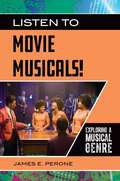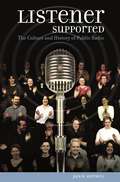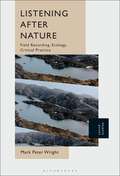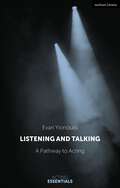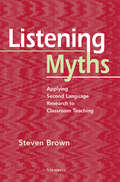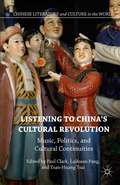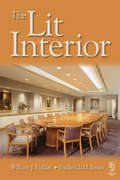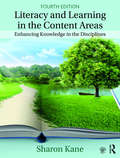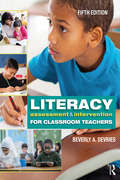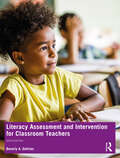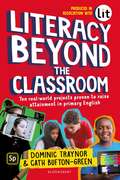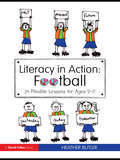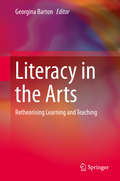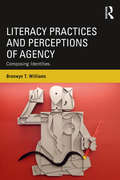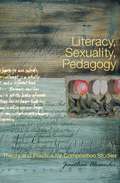- Table View
- List View
Listen to Movie Musicals!: Exploring a Musical Genre (Exploring Musical Genres)
by James E. PeroneListen to Movie Musicals! provides an overview of musical theater on film for fans of the genre, with a focus on 50 must-hear musicals featured in movies.Listen to Movie Musicals! includes an overview of musical theatre and movie musicals in the United States. The 50 movies chosen for critical analysis include many of the best-known film musicals of the past and present; however, the list also includes several important movie musicals that were popular successes that are not necessarily on the "best-of" lists in other books. This volume also includes a greater focus on the actual music of movie musicals than do most other books, making it a stand-out title on the topic for high school and college readers. Like the other books in this series, this volume includes a background chapter followed by a chapter that contains 50 important essays on must-hear movie musicals of approximately 1,500 words each. Chapters on the impact of movie musicals on popular culture and the legacy of movie musicals further explain the impact of both the movies and their songs.
Listen to Movie Musicals!: Exploring a Musical Genre (Exploring Musical Genres)
by James E. PeroneListen to Movie Musicals! provides an overview of musical theater on film for fans of the genre, with a focus on 50 must-hear musicals featured in movies.Listen to Movie Musicals! includes an overview of musical theatre and movie musicals in the United States. The 50 movies chosen for critical analysis include many of the best-known film musicals of the past and present; however, the list also includes several important movie musicals that were popular successes that are not necessarily on the "best-of" lists in other books. This volume also includes a greater focus on the actual music of movie musicals than do most other books, making it a stand-out title on the topic for high school and college readers. Like the other books in this series, this volume includes a background chapter followed by a chapter that contains 50 important essays on must-hear movie musicals of approximately 1,500 words each. Chapters on the impact of movie musicals on popular culture and the legacy of movie musicals further explain the impact of both the movies and their songs.
Listener Supported: The Culture and History of Public Radio (Non-ser.)
by Jack W. MitchellPublic radio stands as a valued national institution, one whose fans and listeners actively support it with their time and their money. In this new history of this important aspect of American culture, author Jack W. Mitchell looks at the dreams that inspired those who created it, the all-too- human realities that grew out of those dreams, and the criticism they incurred from both sides of the political spectrum. As National Public Radio's very first employee, and the first producer of its legendary All Things Considered, Mitchell tells the story of public radio from the point of view of an insider, a participant, and a thoughtful observer. He traces its origins in the progressive movement of the 20th century, and analyzes the people, institutions, ideas, political forces, and economic realities that helped it evolve into what we know as public radio today. NPR and its local affiliates have earned their reputation for thoughtful commentary and excellent journalism, and their work is especially notable in light of the unique struggles they have faced over the decades. This comprehensive overview of their mission will fascinate listeners whose enjoyment and support of public radio has made it possible, and made it great.
Listening After Nature: Field Recording, Ecology, Critical Practice
by Mark Peter WrightListening After Nature examines the constructions and erasures that haunt field recording practice and discourse. Analyzing archival and contemporary soundworks through a combination of post-colonial, ecological and sound studies scholarship, Mark Peter Wright recodes the Field; troubles conceptions of Nature; expands site-specificity; and unearths hidden technocultures. What exists beyond the signal? How is agency performed and negotiated between humans and nonhumans? What exactly is a field recording and what are its pedagogical potentials? These questions are operated by a methodology of listening that incorporates the spaces of audition, as well as Wright's own practice-based reflections. In doing so, Listening After Nature posits a range of novel interventions. One example is the “Noisy-Nonself,” a conceptual figuration with which to comprehend the presence of reticent recordists. “Contact Zones and Elsewhere Fields” offers another unique contribution by reimaging the relationship between the field and studio. In the final chapter, Wright explores the microphone by tracing its critical and creative connections to natural resource extraction and contemporary practice. Listening After Nature auditions water and waste, infrastructures and animals, technologies and recordists, data and stars. It grapples with the thresholds of sensory perception and anchors itself to the question: what am I not hearing? In doing so, it challenges Western universalisms that code the field whilst offering vibrant practice-based possibilities.
Listening After Nature: Field Recording, Ecology, Critical Practice
by Mark Peter WrightListening After Nature examines the constructions and erasures that haunt field recording practice and discourse. Analyzing archival and contemporary soundworks through a combination of post-colonial, ecological and sound studies scholarship, Mark Peter Wright recodes the Field; troubles conceptions of Nature; expands site-specificity; and unearths hidden technocultures. What exists beyond the signal? How is agency performed and negotiated between humans and nonhumans? What exactly is a field recording and what are its pedagogical potentials? These questions are operated by a methodology of listening that incorporates the spaces of audition, as well as Wright's own practice-based reflections. In doing so, Listening After Nature posits a range of novel interventions. One example is the “Noisy-Nonself,” a conceptual figuration with which to comprehend the presence of reticent recordists. “Contact Zones and Elsewhere Fields” offers another unique contribution by reimaging the relationship between the field and studio. In the final chapter, Wright explores the microphone by tracing its critical and creative connections to natural resource extraction and contemporary practice. Listening After Nature auditions water and waste, infrastructures and animals, technologies and recordists, data and stars. It grapples with the thresholds of sensory perception and anchors itself to the question: what am I not hearing? In doing so, it challenges Western universalisms that code the field whilst offering vibrant practice-based possibilities.
Listening and Talking: A Pathway to Acting (Acting Essentials)
by Ms Evan YionoulisListening and Talking: A Pathway to Acting provides undergraduate acting students with a clear, achievable, step-by-step way to approach the work of playing a role. The text is supplemented by exclusive video material to take the actor from their first encounter with the text through rehearsals with fellow actors and into performance. Drawing from the author's twenty years' experience of teaching at the Yale School of Drama, this book, which is influenced, too, by the work of legendary teachers such as Konstantin Stanislavski and Uta Hagen, presents a thorough examination of key aspects of the actor's technique (for example, listening, playing an action and pursuing an objective). Throughout, it includes exercises and process points through which students can put into practice the key lessons from each chapter.The practices laid out in this book form a holistic curriculum that not only ensures measurable results over a semester- or year-long course, but also sets in motion an internal process that will serve the student over their life as an artist.
Listening and Talking: A Pathway to Acting (Acting Essentials)
by Ms Evan YionoulisListening and Talking: A Pathway to Acting provides undergraduate acting students with a clear, achievable, step-by-step way to approach the work of playing a role. The text is supplemented by exclusive video material to take the actor from their first encounter with the text through rehearsals with fellow actors and into performance. Drawing from the author's twenty years' experience of teaching at the Yale School of Drama, this book, which is influenced, too, by the work of legendary teachers such as Konstantin Stanislavski and Uta Hagen, presents a thorough examination of key aspects of the actor's technique (for example, listening, playing an action and pursuing an objective). Throughout, it includes exercises and process points through which students can put into practice the key lessons from each chapter.The practices laid out in this book form a holistic curriculum that not only ensures measurable results over a semester- or year-long course, but also sets in motion an internal process that will serve the student over their life as an artist.
Listening Myths: Applying Second Language Research to Classroom Teaching
by Steven BrownThis volume was conceived as a "best practices" resource for teachers of ESL listening courses in the way that Vocabulary Myths by Keith S. Folse (and Writing Myths by Joy Reid) is one for reading and vocabulary teachers. It was written to help ensure that teachers of listening are not perpetuating the myths of teaching listening. Both the research and pedagogy in this book are based on the newest research in the field of second language acquisition. Steven Brown is the author of the Active Listening textbook series and is a teacher trainer. The myths debunked in this book are: § Listening is the same as reading. § Listening is passive. § Listening equals comprehension. § Because L1 language ability is effortlessly acquired, L2 listening ability is too. § Listening means listening to conversations. § Listening is an individual, inside-the-head process. § Students should only listen to authentic materials. § Listening can’t be taught.
Listening to China’s Cultural Revolution: Music, Politics, and Cultural Continuities (Chinese Literature and Culture in the World)
by Paul Clark Laikwan Pang Tsan-Huang TsaiBringing together the most recent research on the Cultural Revolution in China, musicologists, historians, literary scholars, and others discuss the music and its political implications. Combined, these chapters, paint a vibrant picture of the long-lasting impact that the musical revolution had on ordinary citizens, as well as political leaders.
Lit Interior
by Frederick H Jones William J FielderPresents an organised, comprehensive and easy to understand overview of the lighting design process. It covers every topic from the nature of light itself, through selecting the correct equipment, to preparing project plans and the finished design documents.Using a dummy example the student is taken through an entire project step by step where the full range of alternatives and design processes are illustrated. The easy to read conversational tone makes the novice feel at home with complex technical concepts and provides an excellent introduction to all newcomers to the subject. The book is ideal for those working in architecture, electrical engineering and interior design who will one day design lighting systems for others to build.A companion website runs alongside the book, at http://litinterior.com/, supporting distance learning projects, providing manufacturers data, calculation engines and downloadable courses for carrying our design exercises. The content of the courses will be linked directly to the book.Includes US codes and standards.
Lit Interior
by Frederick H Jones William J FielderPresents an organised, comprehensive and easy to understand overview of the lighting design process. It covers every topic from the nature of light itself, through selecting the correct equipment, to preparing project plans and the finished design documents.Using a dummy example the student is taken through an entire project step by step where the full range of alternatives and design processes are illustrated. The easy to read conversational tone makes the novice feel at home with complex technical concepts and provides an excellent introduction to all newcomers to the subject. The book is ideal for those working in architecture, electrical engineering and interior design who will one day design lighting systems for others to build.A companion website runs alongside the book, at http://litinterior.com/, supporting distance learning projects, providing manufacturers data, calculation engines and downloadable courses for carrying our design exercises. The content of the courses will be linked directly to the book.Includes US codes and standards.
Literacy and Learning in the Content Areas: Enhancing Knowledge in the Disciplines
by Sharon KaneThe Fourth Edition of Literacy and Learning in the Content Areas: Enhancing Knowledge in the Disciplines provides readers with the knowledge, motivation, tools, and confidence for integrating literacy in their disciplinary classrooms. Offering an original, literature-based approach to teaching disciplinary literacy, the new edition shares important ways in which teachers of courses in the disciplines can enhance student learning of subject matter and skills while also fostering their growth in the many facets of literacy. Throughout each chapter, Kane provides engaging and creative strategies and activities to make literacy come alive in discipline-specific courses and to encourage students to explore and learn in the classroom. Embedded in each chapter are examples, resources, and strategies to help readers actively engage with and implement literacy practices. These features include Teaching in Action examples by subject area; Activating Prior Knowledge activities to stimulate critical thinking to prepare readers to learn complex theoretical and conceptual material about teaching, learning, and literacy; and end-of-chapter Application Activities to apply field experiences to classroom use. New to the Fourth Edition Every chapter of this new edition is updated to reflect the current approaches, standards, and benchmarks for discipline-specific literacy. Enhanced Companion Website with BookTalks to introduce relevant books in many genres and subjects, encouraging readers to explore the books for themselves and providing a model for BookTalks in their own classrooms. Expanded practical instructional strategies for teaching literacy in math, science, and social studies. Updated to include newly published titles in children’s literature, young adult literature, and nonfiction.
Literacy and Learning in the Content Areas: Enhancing Knowledge in the Disciplines
by Sharon KaneThe Fourth Edition of Literacy and Learning in the Content Areas: Enhancing Knowledge in the Disciplines provides readers with the knowledge, motivation, tools, and confidence for integrating literacy in their disciplinary classrooms. Offering an original, literature-based approach to teaching disciplinary literacy, the new edition shares important ways in which teachers of courses in the disciplines can enhance student learning of subject matter and skills while also fostering their growth in the many facets of literacy. Throughout each chapter, Kane provides engaging and creative strategies and activities to make literacy come alive in discipline-specific courses and to encourage students to explore and learn in the classroom. Embedded in each chapter are examples, resources, and strategies to help readers actively engage with and implement literacy practices. These features include Teaching in Action examples by subject area; Activating Prior Knowledge activities to stimulate critical thinking to prepare readers to learn complex theoretical and conceptual material about teaching, learning, and literacy; and end-of-chapter Application Activities to apply field experiences to classroom use. New to the Fourth Edition Every chapter of this new edition is updated to reflect the current approaches, standards, and benchmarks for discipline-specific literacy. Enhanced Companion Website with BookTalks to introduce relevant books in many genres and subjects, encouraging readers to explore the books for themselves and providing a model for BookTalks in their own classrooms. Expanded practical instructional strategies for teaching literacy in math, science, and social studies. Updated to include newly published titles in children’s literature, young adult literature, and nonfiction.
Literacy Assessment and Intervention for Classroom Teachers
by Beverly A. DeVriesThe fifth edition of this comprehensive resource helps future and practicing teachers recognize and assess literacy problems, while providing practical, effective intervention strategies to help every student succeed. DeVries thoroughly explores the major components of literacy, offering an overview of pertinent research, suggested methods and tools for diagnosis and assessment, intervention strategies and activities, and technology applications to increase students' skills. Updated to reflect the needs of teachers in increasingly diverse classrooms, the fifth edition addresses scaffolding for English language learners, and offers appropriate instructional strategies and tailored teaching ideas to help both teachers and their students. Several valuable appendices include assessment tools, instructions and visuals for creating and implementing the book's more than 150 instructional strategies and activities, and other resources. New to the Fifth Edition: Up-to-date and in line with ILA, CCSS, and most state and district literacy standards, this edition also addresses the important shifts and evolution of these standards. New chapter on Language Development, Speaking, and Listening covers early literacy, assessment, and interventions. New intervention strategies and activities are featured in all chapters and highlight a stronger technology component. Updated Companion Website with additional tools, resources, and examples of teachers using assessment strategies.
Literacy Assessment and Intervention for Classroom Teachers: For Classroom Teachers
by Beverly A. DeVriesThe fifth edition of this comprehensive resource helps future and practicing teachers recognize and assess literacy problems, while providing practical, effective intervention strategies to help every student succeed. DeVries thoroughly explores the major components of literacy, offering an overview of pertinent research, suggested methods and tools for diagnosis and assessment, intervention strategies and activities, and technology applications to increase students' skills. Updated to reflect the needs of teachers in increasingly diverse classrooms, the fifth edition addresses scaffolding for English language learners, and offers appropriate instructional strategies and tailored teaching ideas to help both teachers and their students. Several valuable appendices include assessment tools, instructions and visuals for creating and implementing the book's more than 150 instructional strategies and activities, and other resources. New to the Fifth Edition: Up-to-date and in line with ILA, CCSS, and most state and district literacy standards, this edition also addresses the important shifts and evolution of these standards. New chapter on Language Development, Speaking, and Listening covers early literacy, assessment, and interventions. New intervention strategies and activities are featured in all chapters and highlight a stronger technology component. Updated Companion Website with additional tools, resources, and examples of teachers using assessment strategies.
Literacy Assessment and Intervention for Classroom Teachers
by Beverly A. DeVriesThe Sixth Edition of this comprehensive resource helps future and practicing teachers recognize and assess literacy problems, while providing practical, effective intervention strategies to help every student succeed. DeVries thoroughly explores all major components of literacy, offering an overview of pertinent research, suggested methods and tools for diagnosis and assessment, intervention strategies and activities, and technology applications to increase students' skills. Substantively updated to reflect the needs of teachers in increasingly diverse classrooms, the Sixth Edition addresses scaffolding for English language learners and the importance of using technology and online resources. It presents appropriate instructional strategies and tailored teaching ideas to help both teachers and their students. The valuable appendices feature assessment tools, instructions, and visuals for creating and implementing the book's more than 150 instructional strategies and activities, plus other resources. New to the Sixth Edition: Up to date and in line with national, state, and district literacy standards, this edition covers the latest shifts in teaching and the evolution of these standards. New material on equity and inclusive literacy instruction, understanding the science of reading, using technology effectively, and reading and writing informational and narrative texts. New intervention strategies and activities are featured in all chapters and highlight a stronger technology component. Revamped companion website with additional tools, videos, resources, and examples of teachers using assessment strategies.
Literacy Assessment and Intervention for Classroom Teachers
by Beverly A. DeVriesThe Sixth Edition of this comprehensive resource helps future and practicing teachers recognize and assess literacy problems, while providing practical, effective intervention strategies to help every student succeed. DeVries thoroughly explores all major components of literacy, offering an overview of pertinent research, suggested methods and tools for diagnosis and assessment, intervention strategies and activities, and technology applications to increase students' skills. Substantively updated to reflect the needs of teachers in increasingly diverse classrooms, the Sixth Edition addresses scaffolding for English language learners and the importance of using technology and online resources. It presents appropriate instructional strategies and tailored teaching ideas to help both teachers and their students. The valuable appendices feature assessment tools, instructions, and visuals for creating and implementing the book's more than 150 instructional strategies and activities, plus other resources. New to the Sixth Edition: Up to date and in line with national, state, and district literacy standards, this edition covers the latest shifts in teaching and the evolution of these standards. New material on equity and inclusive literacy instruction, understanding the science of reading, using technology effectively, and reading and writing informational and narrative texts. New intervention strategies and activities are featured in all chapters and highlight a stronger technology component. Revamped companion website with additional tools, videos, resources, and examples of teachers using assessment strategies.
Literacy Beyond the Classroom: Ten real-world projects proven to raise attainment in primary English
by Dominic Traynor Cath Bufton-GreenImproves English progress at Key Stage 2 by 3.75 times the UK national averageDominic Traynor, the founder of LitFilmFest, and experienced educator Cath Bufton-Green offer a practical method for primary teachers to radically improve English attainment in their classroom.This innovative approach links global challenges including politics, social change, the environment, health and advertising to the five key National Curriculum areas in English: reports, instructions, persuasive language, fiction and poetry, and presentation skills. It develops reading and writing through exciting, real-world tasks such as emailing a politician, creating a viral video and using social media to start petitions. Literacy Beyond the Classroom presents ready-to-use lesson plans, exercises and activities to help teachers bring this concept to life in the primary classroom. This way of learning has been found to improve English progress at Key Stage 2 by 3.75 times the UK national average. The projects can be completed in Adobe Spark.By teaching English in this practical, purposeful and more meaningful way, we can inspire the YouTube generation to learn the literacy skills they need to influence the world around them and have a positive impact as global citizens.
Literacy Beyond the Classroom: Ten real-world projects proven to raise attainment in primary English
by Dominic Traynor Cath Bufton-GreenImproves English progress at Key Stage 2 by 3.75 times the UK national averageDominic Traynor, the founder of LitFilmFest, and experienced educator Cath Bufton-Green offer a practical method for primary teachers to radically improve English attainment in their classroom.This innovative approach links global challenges including politics, social change, the environment, health and advertising to the five key National Curriculum areas in English: reports, instructions, persuasive language, fiction and poetry, and presentation skills. It develops reading and writing through exciting, real-world tasks such as emailing a politician, creating a viral video and using social media to start petitions. Literacy Beyond the Classroom presents ready-to-use lesson plans, exercises and activities to help teachers bring this concept to life in the primary classroom. This way of learning has been found to improve English progress at Key Stage 2 by 3.75 times the UK national average. The projects can be completed in Adobe Spark.By teaching English in this practical, purposeful and more meaningful way, we can inspire the YouTube generation to learn the literacy skills they need to influence the world around them and have a positive impact as global citizens.
Literacy in Action: 24 Flexible Lessons for Ages 9-11
by Heather ButlerGet ready for kick off and prepare to meet all of your literacy goals with Literacy in Action: Football. All year 5 and particularly year 6 teachers know about the pressure to help children deliver levels of achievement laid down by higher authorities than themselves. Many of the reluctant writers are passionate about football. Literacy in Action: Football could be the answer to their and your prayers, offering expert, tried and trusted techniques for teaching literacy, developed within the context of the 'Beautiful Game'. For those not bitten by the football bug there are alternative options. Literacy in Action: Football is a fun and inspiring addition to your literacy teaching. This unique classroom resource contains twenty-four lesson plans, each structured like a football match. For an hour, transform your classroom into Wembley Stadium! Each detailed lesson plan includes: short, kinaesthetic, focussed tasks with instant feedback and praise speaking and listening exercises – children engage in talking and collaborative work before completing a writing task key points from research in to boys’ writing in special notes for teachers alternative tasks available for those not interested in football differentiated material for a wide ability range. Literacy in Action: Football is written by Heather Butler, a writer, literacy consultant and story writing workshop leader. Literacy in Action: Football has been tested extensively by year 5 and year 6 teachers in leafy-green, inner city, multi-cultural and rural settings with amazing results. Why not try it for yourself?
Literacy in Action: 24 Flexible Lessons for Ages 9-11
by Heather ButlerGet ready for kick off and prepare to meet all of your literacy goals with Literacy in Action: Football. All year 5 and particularly year 6 teachers know about the pressure to help children deliver levels of achievement laid down by higher authorities than themselves. Many of the reluctant writers are passionate about football. Literacy in Action: Football could be the answer to their and your prayers, offering expert, tried and trusted techniques for teaching literacy, developed within the context of the 'Beautiful Game'. For those not bitten by the football bug there are alternative options. Literacy in Action: Football is a fun and inspiring addition to your literacy teaching. This unique classroom resource contains twenty-four lesson plans, each structured like a football match. For an hour, transform your classroom into Wembley Stadium! Each detailed lesson plan includes: short, kinaesthetic, focussed tasks with instant feedback and praise speaking and listening exercises – children engage in talking and collaborative work before completing a writing task key points from research in to boys’ writing in special notes for teachers alternative tasks available for those not interested in football differentiated material for a wide ability range. Literacy in Action: Football is written by Heather Butler, a writer, literacy consultant and story writing workshop leader. Literacy in Action: Football has been tested extensively by year 5 and year 6 teachers in leafy-green, inner city, multi-cultural and rural settings with amazing results. Why not try it for yourself?
Literacy in the Arts: Retheorising Learning and Teaching
by Georgina BartonThis book explores the many dialogues that exist between the arts and literacy. It shows how the arts are inherently multimodal and therefore interface regularly with literate practice in learning and teaching contexts. It asks the questions: What does literacy look like in the arts? And what does it mean to be arts literate? It explores what is important to know and do in the arts and also what literacies are engaged in, through the journey to becoming an artist. The arts for the purpose of this volume include five art forms: Dance, Drama, Media Arts, Music and Visual Arts. The book provides a more productive exploration of the arts-literacy relationship. It acknowledges that both the arts and literacy are open-textured concepts and notes how they accommodate each other, learn about, and from each other and can potentially make education ‘better’. It is when the two stretch each other that we see an educationally productive dialogic relationship emerge.
Literacy Practices and Perceptions of Agency: Composing Identities
by Bronwyn T. WilliamsIn this book, Bronwyn T. Williams explores how perceptions of agency—whether a person perceives and feels able to read and write successfully in a given context—are critical in terms of how people perform their literate identities. Drawing on interviews and observations with students in several countries, he examines the intersections of the social and the personal in relation to how and, crucially, why people engage successfully or struggle painfully in literacy practices and what factors and forces they regard as enabling or constraining their actions. Recognizing such moments and patterns can help teachers and researchers rethink their approaches to teaching to facilitate students’ sense of agency as writers and readers.
Literacy Practices and Perceptions of Agency: Composing Identities
by Bronwyn T. WilliamsIn this book, Bronwyn T. Williams explores how perceptions of agency—whether a person perceives and feels able to read and write successfully in a given context—are critical in terms of how people perform their literate identities. Drawing on interviews and observations with students in several countries, he examines the intersections of the social and the personal in relation to how and, crucially, why people engage successfully or struggle painfully in literacy practices and what factors and forces they regard as enabling or constraining their actions. Recognizing such moments and patterns can help teachers and researchers rethink their approaches to teaching to facilitate students’ sense of agency as writers and readers.
Literacy, Sexuality, Pedagogy: Theory and Practice for Composition Studies
by Jonathan AlexanderDespite its centrality to much of contemporary personal and public discourse, sexuality remains infrequently discussed in most composition courses, and in our discipline at large. Moreover, its complicated relationship to discourse, to the very languages we use to describe and define our worlds, is woefully understudied in our discipline. Discourse about sexuality, and the discourse of sexuality, surround us—circulating in the news media, on the Web, in conversations, and in the very languages we use to articulate our interactions with others and our understanding of ourselves. It forms a core set of complex discourses through which we approach, make sense of, and construct a variety of meanings, politics, and identities. In Literacy, Sexuality, Pedagogy, Jonathan Alexander argues for the development of students' "sexual literacy." Such a literacy is not just concerned with developing fluency with sexuality as a "hot" topic, but with understanding the intimate interconnectedness of sexuality and literacy in Western culture. Using the work of scholars in queer theory, sexuality studies, and the New Literacy Studies, Alexander unpacks what he sees as a crucial--if often overlooked--dimension of literacy: the fundamental ways in which sexuality has become a key component of contemporary literate practice, of the stories we tell about ourselves, our communities, and our political investments. Alexander then demonstrates through a series of composition exercises and writing assignments how we might develop students' understanding of sexual literacy. Examining discourses of gender, heterosexuality, and marriage allows students (and instructors) a critical opportunity to see how the languages we use to describe ourselves and our communities are saturated with ideologies of sexuality. Understanding how sexuality is constructed and deployed as a way to "make meaning" in our culture gives us a critical tool both to understand some of the fundamental ways in which we know ourselves and to challenge some of the norms that govern our lives. In the process, we become more fluent with the stories that we tell about ourselves and discover how normative notions of sexuality enable (and constrain) narrations of identity, culture, and politics. Such develops not only our understanding of sexuality, but of literacy, as we explore how sexuality is a vital, if vexing, part of the story of who we are.
